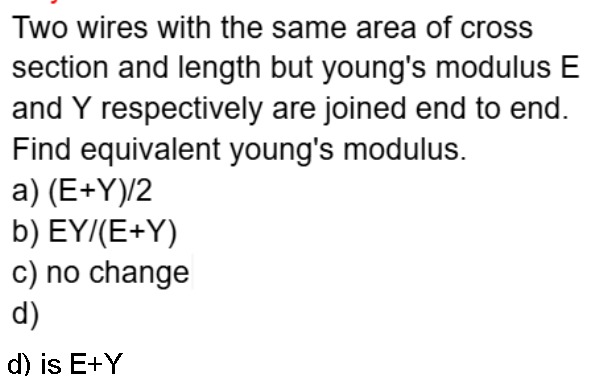Question
Question: Two wires with the same area of cross section and length but young's modulus E and Y respectively ar...
Two wires with the same area of cross section and length but young's modulus E and Y respectively are joined end to end. Find equivalent young's modulus.

(E+Y)/2
EY/(E+Y)
no change
E+Y
(E+Y)/2
Solution
The problem describes two wires joined end to end. This configuration is a series combination. For wires in series, the force (tension) is the same through both wires, and the total extension is the sum of individual extensions.
Let L be the length and A be the cross-sectional area of each wire. Let E and Y be their Young's moduli.
The extension of the first wire is ΔL1=AEFL.
The extension of the second wire is ΔL2=AYFL.
The total extension is ΔLtotal=ΔL1+ΔL2=AFL(E1+Y1)=AFLEYE+Y.
For the equivalent wire, the total length is 2L and the area is A. If Eeq is the equivalent Young's modulus, then ΔLtotal=AEeqF(2L).
Equating the expressions for ΔLtotal: AEeqF(2L)=AFLEYE+Y.
This simplifies to Eeq2=EYE+Y, which gives Eeq=E+Y2EY.
This result is not among the options.
However, if the wires were joined side-by-side (parallel combination), the extension for both wires would be the same, and the total force would be the sum of individual forces.
For parallel combination: F1=ELAΔL and F2=YLAΔL.
Total force Ftotal=F1+F2=(E+Y)LAΔL.
For the equivalent wire, the total length is L and the total area is 2A. Ftotal=EeqL(2A)ΔL.
Equating the forces: (E+Y)LAΔL=EeqL(2A)ΔL.
This simplifies to E+Y=2Eeq, which gives Eeq=2E+Y.
This result matches option (a). Given the options and common exam patterns, it is highly probable that the question intends to describe a parallel combination, despite the wording "joined end to end".
